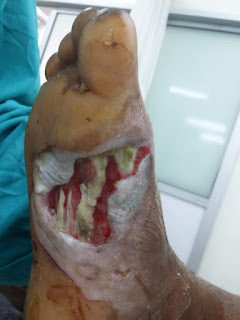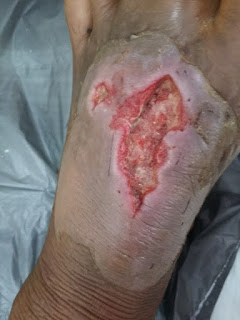(Italicized words and parenthesized words and sentences are for readers purpose only not to
be read when presenting a case. The letters In Blue are points of special
interest to be discussed later.
All
the patients may not have the same symptoms at presentation and the same risk
factors, so history taking should always be INDIVIDUALISED than generalised to
a standard sets of check list.It is always RECOMMENDED to ask the patient their
problems and the question associated with the problem as per the need.
Interpersonal
variations are always exists in the way the history is taken and written.
Pattern, format and style of history taking and presenting are subject to
change as per institutional protocol and region.Please kindly follow the system
that is acceptable in your context.)
A
case of COPD
Patient Particulars
Name
: Mr Magar
Age
: 68 years
Sex:
Male
Religion:
Hindu
Occupation
: Farmer
Marital
Status : Married
Address:
Ramechhap
Date
of admission : 24th August 2017
Date
of examination : 29th August 2017
Mode
of admission: Emergency Room
 (Mr
Magar, 68yrs gentleman, a married, hindu, farmer from Ramechhap presented to
XYZ hospital emergency 5 days back with )
(Mr
Magar, 68yrs gentleman, a married, hindu, farmer from Ramechhap presented to
XYZ hospital emergency 5 days back with )
Chief
complaints
1. Shortness of breath x 12
years aggravated for last 5 days
2. Fever x 5 days
History
of Present illness
According to the patient, he was apparently well 12 years back, then he
graduallly developed shortness of breathe which was initially present while
walking uphill (MMRC
grade 1) and gradually progressed
over time and had to stop while walking about 100m on level ground (MMRC grade 3)
in 12 years time. But for the past 10 days, the shortness of breathe is
severe enough to compromise his daily activity (MMRC grade 4). Mild
improvement was seen after use of inhalational drug.Patient uses 2 pillows to sleep (orthopnea)
and gives history of occasional sudden awakening at night with severe air
hunger and has to stand up and open window before the symptoms are relieved(PND).
The shortness of breath is associated with cough and sputum production. He has
bouts of cough more in the morning,
on and off, aggravated by smoking and exposure to
dust and cold and has mild chest pain. The patient also gives history of
sputum production which is thick
, mucoid, whitish in color, about a tablespoon full and non foul
smelling. There is no blood in the sputum. But for the last five days the
sputum is more copious, around a cup full
and the color has changed from white to yellow.
The patient gives history of
high grade fever for 5 days, insidious in
onset, on and off, more in the morning,
associated with chills but no rigor and sweating. The temperature was not
documented at home. Patient complains of
generalised weakness and muscle pain. No
history of rashes, sore throat, headache.
The patient does not gives
history of palpitation, lightheadedness and central chest pain. No complains of
bluish discoloration of face and lips at the bouts of coughing (No cyanotic spell at end of cough). No
swelling of the limbs and adbomen (No corpulmonale).
No history of weight loss, no anorexia
and easy fatigualbility. (Generalised
symptoms)
No diarrhoea, vomiting, pain
abdomen or abdominal distension. No dark colored stool or yellowish
discoloration of skin. No history of burning micturition, urgency or frequency.
(No Other foci of Fever )
No abnormal body movement,
excessive drowsiness or confusion. No complains of headache (No chronic CO2 retention), photophobia and
stiffness of the neck. (No other foci of
fever)
No joint pain, pus draining sites
or history of trauma.
History
of past illness
The patient gives history of
similar illness 2 years back for which he
was hospitalized and was managed with oxygen and Iv medications. He had TB for which he completed a course of 6 months of
treatment 15
years back. No other chronic illnesses like DM, HTN, Epilepsy. No
history of any surgical intervention.
Personal
history
Patient is a chronic smoker and has consumed about 40-45 pack years of cigarette (including bidi and
hookah) for the past 50 years. But has stopped smoking for the last 2 years .
Patient was a chronic alcoholic and consumed
around 1 manas of locally made alcoholic
beverage (local unit = 500ml, assuming 30-40% of alcohol) which corresponds to for
1.5-2 units of alcohol for the last 40 years but has stopped consuming
for last 2 years.
He is non vegeterian and has
normal bowel and bladder habit.
Sleep pattern is
occasionally disturbed by sudden onset of severe shortness of breathe.
Family
history
He has 8 members in the
family.
No similar illness in the
family.
No chronic illness like DM,
HTN, TB or any cancers in the family.
Socioeconomic
history
He belongs to a poor family.
He uses fire wood and cattle dung cake for
cooking food. The ventilation is inadequate and
there is congestion of smoke inside the
house. The roof is thatched and they store grain in the same room they use for
daily purposes. They have adequate provision of clean drinking water and toilet
facilities.
Drug
and allergy history
He has been taking from inhalation drug prescribed 2 years back but is not
fully complaint with drug. No use of any drug for prolonged duration. No known history
of allergy to any drug, food or other substance.
Summary
58 years chronic smoker with
40 packs years of smoking, with previous history of PTB 15 years back, presented with SOB with MMRC grade 1
initailly, progressed to MMRC grade 3 over 12 years, associated with mucoid,
scanty sputum more in the morning. But recently
SOB has been worse (MMRC grade 4 ) with high grade fever and purulent
sputum for the last 10 days. The patient
is a chronic alcoholic, uses firewood to cook and has been taking inhalational
medication irregularly. Patient gives history of similar episode 2 years back.
(We
generally do not include negative history in the summary. This includes only
the positive points)
Provisional
Diagnoses based upon history
Acute exacerbation of COPD
Differential
diagnosis
Pneumonia
Pulmonary Tuberculosis
Interstitial Lungs disease
Bronchial asthma
Lungs carcinoma
The
following table show what is the significance of most of the points mentioned
in the history described above. Parenthesized are the point of interest in that
specific condition. The positive (+) and Negative (-) sign here are to signify
the presence or absence of the symptoms or history is favoring or rejecting any
of the differential diagnoses. The greater the number of signs, the stronger is
the favoring point or rejecting point .
History
|
Points of interest
|
AE of COPD
|
Pneumonia
|
Pulmonary TB
|
Asthma
|
Interstitial Lungs
Disease
|
Lungs Cancer
|
Patient particulars
|
Age 65 yrs
|
++
|
+/-
|
+/-
|
-
|
++
|
+++
|
|
Occupation
|
+
(Exposed
to dust )
|
|
?
labourous job … undernutrition (poor)
|
++
(exposed
to dust, allergen, pollen, animal danders)
|
++
(Exposed
to dust )
|
|
Chief complain
|
SOB x 12 yr
|
+++
|
-
|
-
|
+
|
+++
|
+/-
|
|
Increased for past
5 days
|
+++
(Acute
on chronic )
|
+++
(precipated
under some underlying condition)
|
+
|
+
|
-
|
-
|
|
Fever for 5 days
|
+++
(acute
exacerbation otherwise absent)
|
++++
(active infection )
|
+
(Chronic
infection)
|
-
|
-
|
-
|
HOPI
|
MMRC Grade 1 to 3
in 12 years
|
+++
(insidious
onset )
|
-
|
+
(insidious onset but 12 years too long )
|
++(
|
+++
(insidious
onset )
|
++
(insidious
onset but 12 years too long )
|
|
MMRC grade 4 in 5
days
|
+
|
+++
(rapid progression)
|
+
|
+++
|
---
(Rarely
acute exacerbation)
|
++
|
|
Mild improvement
with inhalational drug (? SABA)
|
++
|
|
|
+
(Good
improvement seen in early stages of the disease)
|
|
|
|
Orthopnea
|
?
Corpulmonale
|
|
|
|
Exposed
to dust
|
|
|
PND/ night symptoms
|
++
|
|
|
+++
(Rather
night symptoms)
|
++
|
|
|
Cough in morning
|
+++
(Chronic Bronchitis)
|
+
|
+
|
+
(More
on night)
|
+
|
|
|
Mucoid non purulent
scanty
|
++
|
-(Purulent)
|
++
|
++
|
+
|
+/-(Serous
/ Mucoid)
|
|
Recently purulent,
copious and yellow
|
-
|
+++
|
+++
|
_
|
---
|
-
|
|
High grade fever
|
|
++
(Active Infection)
|
+
(Low
grade fever for prolonged duration)
|
|
-
|
|
|
Generalised
weakness
|
+
Chronic
poor respiratory effort
|
++
|
+
|
+
|
+
(Chronic
poor respiratory effort)
|
+++
(more
generalised symptoms)
|
Neagtive hsitory
|
NO hemptysis
|
|
+/-
|
---
(Commonly
seen)
|
|
|
---
(Commonly )
|
|
No weight loss
|
|
|
---
Commonly
seen
|
|
|
----
Commonly
seen
|
|
No anorexia
|
|
|
---
Commonly
seen
|
|
|
----
Commonly
seen
|
Past history
|
Similar illness in
past
|
++
(recurrent
infection)
|
|
+
Risk
factor
|
+++
Acute
exacerbations of asthma
|
|
|
|
PTB and ATT therapy
|
Risk
factor
|
|
Risk
Factor
|
|
|
|
|
No DM ( not immuno
compromised)
|
|
Risk
|
Risk
|
|
|
|
Personal history
|
40 pack years
smoking
|
+++
|
|
++
|
++
|
++
|
++++
|
|
Alchohol
|
|
+(aspiration)
|
++
|
|
|
+
|
|
Disturbed sleep
|
PND
|
|
|
Night
symptoms
|
|
|
Family history
|
8 member
|
|
|
Overcrowding
|
|
|
|
|
TB
|
Risk
|
|
Contact
history absent
|
|
|
|
Socioeconomic
|
Poor family
|
|
|
Risk
factor
|
|
|
|
|
Indoor pollution
|
++++
Precipitates
|
|
++
Risk
factor
|
++
Risk
factor
|
|
Risk
factor
|
|
Thatched roof and
grain storage (? Fungal Allergen)
|
|
|
|
--
Risk
factor
|
|
|
Drug allergy
|
Inhalational drug
|
++
?
Salbutamol for acute exacerbation
|
|
|
++
?
Salbutamol fro acute exacerbation
|
++
Bronchodilators
|
|
|
No prolonged Drug
therapy
(Steroids, NSAIDS,
aspirin , immunomodulators)
|
|
|
--
Reactivation
of TB (steroid, immunomodulator drugs)
|
--
Aspirin,
NSAIDS precipitates
|
--
Use
of bleomycin, amiadarone, metho-trexate can cause pulmonary fibrosis
|
|
|
History of Atopy
|
|
|
|
---
STRONG
RISK FACTOR
|
|
|
DISCUSSION
Why do you think this is
COPD?
All the point mentioned in Summary are the points
are in favor of acute exacerbation COPD most likely secondary to a bacterial
infection. Always tell your point in the same fashion you presented your
history and just do not jump directly to the Chief complains or the history of
present illness. Because age, occupation is of equal significance. The presence
of past infection, risk factors such as previous history of PTB that can cause
cavitary changes in lungs and other damages to lung parenchyma causes COPD.
Risk factors such as smoking, use of firewood all those should be mentioned
from TOP to BOTTOM.
Why
not other condition?
Though TB has insidious
onset and progression, but duration as long as 12 years may not be seen in PTB
and Cancer. The patient may not last such a long duration with such active and
significant morbidity. Active TB develops
generally over months to rarely few years. TB has low grade fever arising for
more than 15 days or more and high grade fever only if there is a super
infection upon the immunocompromised state of TB. But no other gross foci of
fever are seen in this condition other than the lungs. Presence of Diabetes
would have precipitated PTB.
The sputum was initially
mucoid and whitish suggesting a chronic lung condition, which when precipitated
by active infection may cause change in the sputum amount and color, most
likely pneumonia than TB. The presence of hemoptysis could have strongly
suggested TB but on its absence we can not rule out TB. The more generalised
symptoms of weakness is present but anorexia is absent. The sudden aggravation
of shortness of breath can not be justified unless there is development of
pulmonary effusion in PTB.
However we do not see
orthopnea, PND in TB. Rather PND, Orthopnea develops if the patient has left
sided heart failure, and some times in pulmonary HTN. Cor pulmonale secondary to COPD can cause
pulmonary HTN and left sided heart failure to cause PND and Orthopnea. PND type
acute bouts of SOB can be seen in Bronchial asthma as its night symptoms but
asthma is less likely seen in elderly but
we can't say its Unlikely. The cough is more in the evening and night
rather than morning but asthma can be precipitated with cold and dust.
The risk factor such as previous
history of PTB treated with antitubercular therapy, overcrowding, poor
socioeconomic condition can support the diagnosis of TB. Similarly, presence of
risk factors like chronic cough aggravated with dust and smoke favors asthma. Absence
of atopy is however against the asthma.
Interstitial diseases are
insidious onset and progresses over a long duration of time. However there is
rarely any features of acute exacerbation, rather they develop signs of
pulmoary hypertension and Orthopnea, PND and right heart failure would be more
signifcant. Similarly, the risk factors such as farming, use of smoking and
exposure to indoor pollution can favor the diagnoses.
Carcinoma can be ruled out
in the presence of more acute symptoms and more very very long onset of symptom
which may not justify the presence of Carcinoma. No hemoptysis, no weight loss,
No other systemic complains besides generalised weakness may not also favor
malignacy. But for his age we just can not rule out maligncancy.
This
discussion is incomplete and just a review of how things can be done. Depending
upon what you have written in your history you have to support your provisional
diagnosis. Answering a examiner would not be a big deal if you can sort out the
informations in your mind, thesame way I have presented in the table, the
points that favors any diagnosis and what was needed or absence of which make
any of your provisional diagnosis unlikely.
Since,
history taking can not be sufficient to rule out all other differential
diagnoses the examination is must. So we don not have to worry if we can
not make a single provisional diagnosis
just from history. But you should be able to rule out 2-3 differential
diagnoses by the time you complete your history. Even on the completion of
examination, it may not be crystal clear but still you can rule out more of
diagnoses. Still we have diagnostic tools to come to conclusion. So , history
taking is just a part of this process and not a complete process in itself. So,
Don’t worry even if you confuse yourself
or examiner at the end of history taking.
*** Disclaimer : This is a hypothetical
case and is not a real life scenario. However, the condition is so common and prevalent,
it is a coincidence if it matches with the life of any. This case is solely for
educational purpose with no intentions meant otherwise.***





